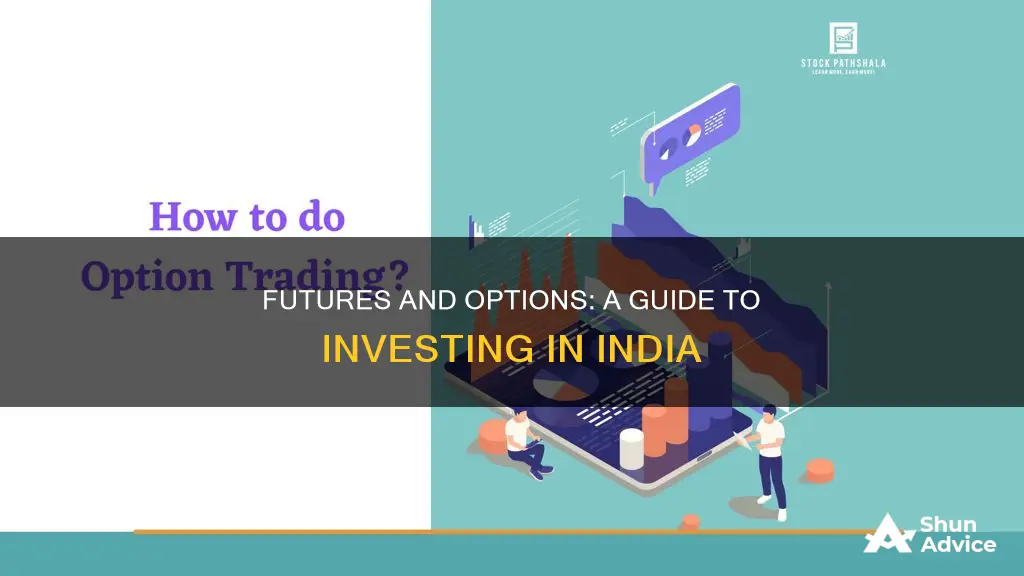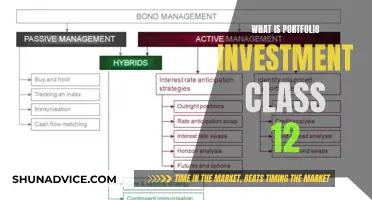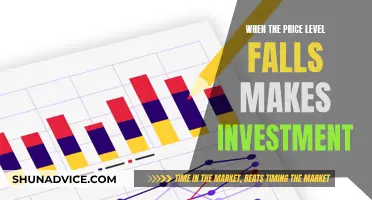
Futures and options are complex financial instruments that can be lucrative but also carry significant risks. Before investing in them, it's crucial to understand their fundamental differences and how they work.
Futures and options are derivatives, meaning their value is derived from an underlying asset such as stocks, commodities, or currencies. They are contracts between two parties to buy or sell these underlying assets at a predetermined price and date. However, the key difference is that futures represent an obligation to trade, while options give the buyer the right but not the obligation to trade.
In India, investors can trade futures and options on the National Stock Exchange (NSE) and the Bombay Stock Exchange (BSE). It's important to have a solid understanding of the market and these instruments before investing. This includes knowing the risks involved, such as market fluctuations, liquidity issues, and unexpected events affecting prices.
To invest in futures and options, you'll need to open a trading account with a broker. You'll also need to deposit margin money, which is a percentage of the contract value, as security for the trade.
While futures and options offer the potential for high returns, they also carry the risk of significant losses. It's important to approach these investments with caution and a thorough understanding of the market and your own risk tolerance.
What You'll Learn

Understand the basics of futures and options trading
Futures and options are complex financial instruments that require specific knowledge and skills to trade. They are a type of derivative product, which means that their value is derived from an underlying asset or commodity. While they share this commonality, futures and options also have some key differences. This guide will cover the basics of futures and options trading in India, including the differences between the two, the process of trading, and some important considerations.
Differences Between Futures and Options:
- Right vs. Obligation: Futures represent a commitment to trade that must be fulfilled by both parties at a specified date, while options give the buyer the right but not the obligation to exercise the contract.
- Date of Trade: In futures trading, the trade must occur on the agreed-upon date. With options, there can be variations, but generally, they can be exercised any time until the expiration date.
- Advance Payments: There are no upfront costs for futures contracts. However, a "margin" (a certain percentage of the trade value) must be put up, which can magnify gains and losses. Options, on the other hand, require the buyer to pay a premium.
- Risk: Options provide more flexibility and theoretically reduce the risk of loss as buyers can choose not to exercise the contract if it's not profitable. In contrast, futures trading must occur at the specified date, regardless of the price.
Types of Futures and Options:
Futures: Futures are standardised contracts with the same set of rules for buyers and sellers. They can be further categorised into financial futures (e.g. stock futures, currency futures) and physical futures (e.g. commodity futures, energy futures).
Options: Options can be of two types: call options and put options. Call options allow the buyer to purchase the underlying asset at an agreed-upon price and date, while put options allow the buyer to sell the asset at a specified price and date.
Process of Trading in Futures and Options:
To trade in futures and options in India, follow these steps:
- Open a Trading Account: Choose a trusted broker and open a trading account. Look for a user-friendly platform and consider the fees involved.
- Educate Yourself: Expand your knowledge by reading books, taking online courses, and utilising other educational resources. Understand the differences between futures and options, as well as the risks and costs associated with each.
- Practice with a Simulated Account: Before trading with real money, consider using paper trading or practice accounts to gain experience and build confidence without risking capital.
- Seek Professional Guidance: If needed, reach out to professional traders or financial advisors for mentorship and help in developing a personalised trading plan.
- Select a Trading Platform: Research and choose a suitable trading platform, such as the National Stock Exchange (NSE) or the Bombay Stock Exchange (BSE), which offer futures and options trading.
- Place Orders: Work with your broker to place your trading orders, specifying the contract details, quantity, strike price, and expiration date.
- Manage Your Position: Depending on market movements and your risk appetite, you may choose to offset (close) your position before expiry, exercise the position, or let the contract expire.
Important Considerations:
- Risk and Volatility: Futures and options trading carries a significant level of risk due to leverage and market volatility. Understand your risk appetite and set appropriate stop-loss and take-profit levels to manage your trades effectively.
- Costs and Margins: Be mindful of the various costs associated with trading, including brokerage, statutory charges, stamp duty, and taxes. Additionally, margins required for futures contracts can fluctuate with market volatility, so ensure you have sufficient funds to meet margin calls.
- Time Sensitivity: Options contracts have expiration dates, and their value can decline over time due to time decay. Plan your trades carefully, especially for shorter-term options.
- Psychological Pressure: The fast-paced and volatile nature of futures and options trading can create psychological pressure. It's important to manage your emotions and maintain a disciplined approach.
Smart Ways to Invest 70 Lakhs in India
You may want to see also

Know your risk appetite
Before investing in futures and options, it is crucial to assess your risk appetite or the amount of risk you are willing to take. This is an important consideration as derivatives trading is inherently risky and can lead to significant losses. Here are some factors to keep in mind:
- Understanding the Risks: Derivatives trading, especially in the futures and options market, carries a high level of risk. It is important to recognize that 9 out of 10 individual traders in this market incur net losses. While the potential for high returns exists, the risk of substantial losses is equally present. Leverage can amplify these losses, and market volatility can work against your trades. Therefore, it is essential to have a realistic understanding of the risks involved.
- Assessing Your Financial Situation: Consider your financial situation and determine how much money you can afford to lose. Evaluate your income, expenses, and financial obligations to decide how much capital you can allocate to derivatives trading. Remember that losses in this market can be significant, so ensure that you are not risking money that you cannot afford to lose.
- Impact on Lifestyle: Reflect on the potential impact of losses on your lifestyle. Ask yourself if losing a certain amount of money would affect your standard of living or your ability to meet financial commitments. It is important to strike a balance between pursuing potential gains and preserving your financial stability.
- Risk Tolerance: Everyone has a different tolerance for risk. Some people are comfortable taking on more risk in pursuit of higher returns, while others prefer a more conservative approach to protect their capital. Evaluate your own risk tolerance and decide how much risk you are willing to take. Remember, derivatives trading may not be suitable for everyone, and it is essential to make informed decisions based on your personal circumstances.
- Experience and Knowledge: Consider your level of experience and knowledge in the derivatives market. Derivatives trading requires a solid understanding of market dynamics, trading strategies, and risk management techniques. If you are a beginner, recognize that you may need more time to grasp the intricacies of this complex market. Starting with smaller trades or practising with simulated accounts can help you gain experience and build your risk management skills over time.
- Diversification: Diversification is a risk management technique that can help reduce your overall risk. By spreading your investments across different asset classes and markets, you can lower the impact of losses in any single investment. Consider how derivatives trading fits into your broader investment portfolio and ensure that you are not overexposed to a specific market or asset class.
In conclusion, knowing your risk appetite is a crucial step before investing in futures and options. It involves assessing your financial situation, understanding the risks involved, and determining how much risk you are comfortable taking. By carefully considering these factors, you can make more informed and suitable investment decisions in the derivatives market.
Investment Management: A Decade of Portfolio Experience
You may want to see also

Choose your trading strategy
Before you begin trading in futures and options, it is important to decide on a strategy that suits your needs and risk appetite. Here are some key considerations to help you choose your trading strategy:
- Understanding the basics: Futures and options are complex financial instruments that differ significantly from traditional stock or mutual fund investments. It is crucial to have a strong grasp of how these derivatives work, the risks involved, and the costs associated with trading them.
- Risk appetite: Determine how much risk you are comfortable taking. Futures and options trading can offer high returns, but it also comes with the potential for significant losses. Know how much money you can afford to lose without affecting your lifestyle.
- Trading approach: Decide whether you want to trade based on your own research and analysis or seek the assistance of an expert. If you choose to trade independently, consider using simulated trading accounts to gain practical experience without risking real money.
- Margin requirements: Futures and options trading typically involve margin requirements, where you need to deposit a portion of the contract value upfront. Ensure you have the necessary funds to meet these requirements, as failing to do so may result in position liquidation.
- Trading platform: Choose a trusted broker that offers a user-friendly trading platform. Look for brokers that provide educational resources, practice accounts, and professional guidance if needed.
- Market analysis and research: Conduct thorough research and analysis before entering any trades. Study the underlying assets, market trends, historical data, and relevant news and events that can impact prices. A deep understanding of market behaviour is crucial for successful trading.
- Volatility and liquidity: Assess the volatility and liquidity of the underlying assets. Volatility affects options pricing, while liquidity impacts your ability to enter and exit positions smoothly. Consider using indicators and strategies to navigate volatile markets.
- Time sensitivity: Options contracts have expiration dates, and their value can decline over time due to time decay. Plan your trades carefully, taking into account the time sensitivity of options and the potential impact on your profits.
- Risk management: Implement risk management techniques such as stop-loss and take-profit orders to limit potential losses and secure profits. Diversification across different assets and markets can also help manage risk.
- Costs and fees: Be mindful of the various costs associated with futures and options trading, including brokerage costs, statutory charges, stamp duty, and transaction taxes. These costs can add up quickly, especially with frequent trading, so factor them into your overall trading strategy.
Understanding Your Investment Portfolio Reports: Why They Matter
You may want to see also

Practise with a simulated account
Once you have understood how futures and options trading works, you can try practising on a simulated trading account, which is available online. This will enable you to gain first-hand practical experience on how the futures markets work, without making any actual investments.
Paper trading and practice accounts
Don't rush into trading with real money right away. Instead, consider using paper trading or practice accounts offered by brokers. These allow you to trade with virtual funds and test your strategies in a risk-free environment. It's a great way to gain experience and confidence.
Practice trading with virtual currency
You can use a trading simulator to test and plot new strategies for stocks, options, and futures, featuring a complete toolkit. You can stretch the limits of your strategy with unlimited paper dollars and balance resets. You can also choose from more than 180 built-in indicators to create strategies or build your own.
Options and futures trading simulators
Users can try different trading strategies in the real-time stock market as well as on historical data using options and futures stock trading simulators.
Zero-risk simulated trading
You can use a free stock market simulator to practice buying and selling in the stock market with absolutely zero risk and unlimited virtual dollars.
Moneybhai
Moneybhai is a stock trading simulator that comes with 1 crore virtual cash and a 1 crore intraday trading limit as soon as you create your portfolio account. Virtual money can be used for trading in assets such as mutual funds, shares, fixed deposits, etc. Beginners can access stock advice from industry experts and veterans based on years of technical analysis and research.
Wall Street Survivor
Wall Street Survivor focuses on educating traders through their interactive courses and learning materials. It gives you the opportunity to trade in real time in ETFs, crypto, US stocks, and more with virtual money of $100,000. Users can also access free courses on stock trading created for beginners and professionals.
TradeStation
TradeStation is used by trading practitioners to practise new and advanced trading strategies using unlimited virtual currency. Users also have the option to back-test their strategies or apply them in real-time to check their results. The stock simulator is also great for experienced traders as it allows strategy automation, access to alternate market types, and placing advanced orders without losing any real money.
NinjaTrader
NinjaTrader is a popular stock trading simulator that is completely free for its users. Its strategy backtesting option allows you to simulate your automated trading ideas using historical trading data. Its trading indicators, real-time scanners and stock charting tools are highly interactive. Users can also play, pause or rewind the historical market data in a synchronized manner as it was happening in real time.
MoneyPot
MoneyPot is a web-based trading simulator for the Indian stock market, specially designed for universities, corporations and colleges. MoneyPot helps traders try strategies of different types without the fear of losing real money. Students benefit explicitly from this scalable trading platform as it provides a complete experience of a real-time trading environment.
Setting Up Your Virtual Investment Portfolio: A Step-by-Step Guide
You may want to see also

Open a trading account
To start trading in futures and options, you need to open a trading account. Do a thorough background check of the broker before opening an account. You should also inquire about the fees. While investing in futures, it is important to select a trading account that suits your requirements.
The first step to begin trading and understanding how to trade in futures and options is to create a trading account with a broker where you can buy and sell futures and options contracts. These contracts are bought via BSE or NSE-registered broking firms. Once your account is created, you can log on to the portal or choose the mobile application option and browse through the various F&O options available.
After picking a platform, research which futures and options are available and which one suits you better. After finalising your choice, put in the order details, and now you can buy the futures and options at the strike price. It is the price at which a call (option contract owner buys the underlying security) or put option (option contract owner sells the underlying security) is exercised. You buy a Call Option or sell a Put Option if you predict the prices to rise, and vice versa if you predict the price to go down.
Active Investment Management: Why It's Worth the Effort
You may want to see also
Frequently asked questions
Futures and options are stock derivatives that are traded in the share market. They are a type of contract between two parties to buy or sell a stock or index at a specific price or level at a future date.
Futures are an obligation for both the buyer and seller, where they have to trade at a pre-established value of the underlying asset. Options are not obligations but a right of the buyer, where they can trade at a pre-established price of the underlying security.
You need to open a trading account with a broker. You can then buy and sell futures and options contracts via BSE or NSE-registered broking firms.
Trading in futures and options can be profitable, but it also carries significant risks. One of the benefits is that you can hedge against market risk. However, it requires a lot of knowledge and experience, so beginners should tread with caution.







